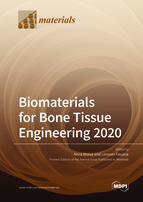Biomaterials for Bone Tissue Engineering 2020
A special issue of Materials (ISSN 1996-1944). This special issue belongs to the section "Biomaterials".
Deadline for manuscript submissions: closed (10 November 2022) | Viewed by 38271
Special Issue Editors
Interests: bone regeneration; biomaterials; mesenchymal stem cell differentiation, cell–biomaterial interaction; bone regeneration; cell culture; molecular biology; cell biology; tissue engineering; biocompatibility; scaffolds; nanomaterials; cellular mechanisms
Special Issues, Collections and Topics in MDPI journals
Interests: tissue engineering via biomaterials and physical stimuli
Special Issues, Collections and Topics in MDPI journals
Special Issue Information
Dear Colleagues,
Over the last few decades, a variety of tissue engineering strategies have been developed to improve the regenerative properties of bone biomaterials (e.g., osteoinduction and osteoconduction). This Special Issue on “Biomaterials for Bone Tissue Engineering” will provide an overview of the recent advances and cutting-edge approaches in the field of bone biomaterials and bone tissue engineering, including the new molecular insights on the various aspects of the interaction of bone substitutes with cells and tissues. Contributions reporting innovative materials, osteoinduction and osteoconduction approaches, and examples of combination with biochemical and/or physical stimuli and/or different cell types (e.g., stem cells, macrophages, endothelial cells) tested for their application in bone tissue regeneration and engineering are welcome.
Thus, we invite the submission of original full papers, communications, and comprehensive reviews describing the latest progress.
Best Regards,
Dr. Nora Bloise
Dr. Lorenzo Fassina
Guest Editors
Manuscript Submission Information
Manuscripts should be submitted online at www.mdpi.com by registering and logging in to this website. Once you are registered, click here to go to the submission form. Manuscripts can be submitted until the deadline. All submissions that pass pre-check are peer-reviewed. Accepted papers will be published continuously in the journal (as soon as accepted) and will be listed together on the special issue website. Research articles, review articles as well as short communications are invited. For planned papers, a title and short abstract (about 100 words) can be sent to the Editorial Office for announcement on this website.
Submitted manuscripts should not have been published previously, nor be under consideration for publication elsewhere (except conference proceedings papers). All manuscripts are thoroughly refereed through a single-blind peer-review process. A guide for authors and other relevant information for submission of manuscripts is available on the Instructions for Authors page. Materials is an international peer-reviewed open access semimonthly journal published by MDPI.
Please visit the Instructions for Authors page before submitting a manuscript. The Article Processing Charge (APC) for publication in this open access journal is 2600 CHF (Swiss Francs). Submitted papers should be well formatted and use good English. Authors may use MDPI's English editing service prior to publication or during author revisions.
Keywords
- bone regeneration
- bone tissue engineering in vitro and in vivo
- bone substitutes
- bone marrow stem cells
- adipose derived stem cells
- growth factors
- cell/tissue–biomaterials interaction
- physical stimuli (ultrasound, laser, electric or electromagnetic field, shear stress, etc.)
- bioreactors
- molecular mechanisms
Related Special Issue
- Biomaterials for Bone Tissue Engineering (Second Volume) in Materials (3 articles)







